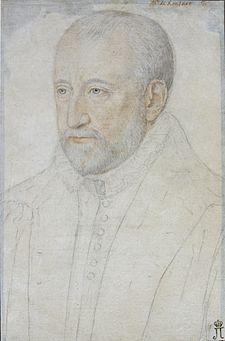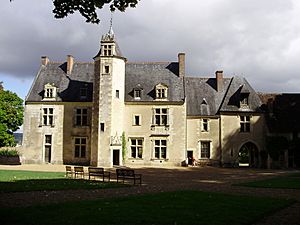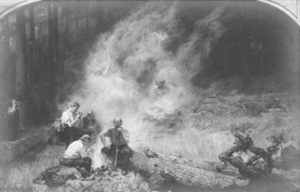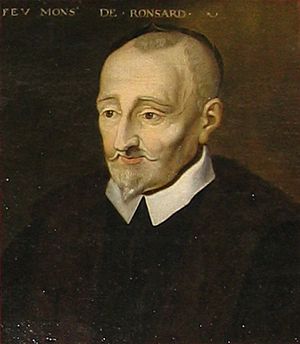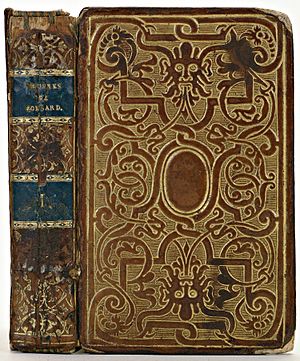Pierre de Ronsard facts for kids
Pierre de Ronsard (born September 11, 1524 – died December 27, 1585) was a very famous French poet. People in his time called him the "prince of poets" because he was so good at writing. He was a key member of a group of poets called the Pléiade. This group helped shape French poetry during the 1500s.
Contents
Early Life and Travels
Pierre de Ronsard was born at the Manoir de la Possonnière. This was in a village called Couture-sur-Loir in France. His family was noble and well-known. His father, Louis de Ronsard, worked for King Francis I.
Pierre was the youngest son in his family. He was taught at home when he was very young. At nine years old, he went to the Collège de Navarre in Paris.
When Madeleine of France married James V of Scotland, Ronsard became a page in the Scottish court. There, he was encouraged to translate old classical writings into French. After the queen died, he traveled back to France, passing through England.
He also traveled to Flanders and Holland. He even went back to Scotland for a short time. These trips were part of his work on diplomatic missions. He served important people like Lazare de Baïf and Cardinal du Bellay-Langey.
Becoming a Poet
Ronsard's plans for a career in diplomacy changed suddenly. In 1540, he became deaf after a trip to Alsace. No doctor could cure him. Because of this, he decided to focus on studying instead.
He chose to study at the Collège Coqueret in Paris. The head of this school was Jean Daurat. Daurat later became a key member of the Pléiade group. Other future poets, like Antoine de Baïf and Remy Belleau, also studied there. Joachim du Bellay, another important poet, joined them soon after.
Ronsard studied for seven years. During this time, a new literary movement began. It aimed to use ideas from classical Greek and Roman writers in French writing. The first important book of this movement was Défense et illustration de la langue française by Du Bellay in 1549.
This group was first called the "Brigade," but later became known as the Pléiade. There were seven main writers in the group: Ronsard, Du Bellay, Baïf, Belleau, Pontus de Tyard, Étienne Jodelle, and Daurat.
Ronsard's own work started appearing a little later. In 1550, he published the first four books of his Odes. Then, in 1552, he published his Amours de Cassandre. These books were dedicated to Cassandre Salviati, a 15-year-old girl he met. His new style of writing caused a big debate among writers at the time.
Ronsard's Fame and Royal Support
Ronsard became very popular very quickly. He was also quite successful. He published his Hymns in 1555. In 1556, he finished his Amours poems. In 1560, he released a collection of his complete works. This was possibly at the request of Mary, Queen of Scots.
Kings of France continued to support Ronsard. King Charles IX was even more supportive than earlier kings. He gave Ronsard rooms in the palace and made him the head of several abbeys. The king also saw Ronsard as his poetry teacher.
However, this royal support also caused problems. People who were against the king, called Huguenots, disliked Ronsard. They wrote mean poems about him. They even tried to make him look bad by saying he was an atheist. They also tried to make another poet, Du Bartas, seem better than Ronsard.
Ronsard even said that some people tried to kill him. During this time, he started writing a long poem called the Franciade (1572). This poem was never finished and is not considered his best work. It was published around the same time as the St Bartholomew's Day massacre, a terrible event in French history. This made people less interested in his poem.
After King Charles IX died, Ronsard still had royal favor. But he also started to get sick more often. This made him decide to leave court life. He spent his last years living in his own houses in Vendôme and Touraine. He was financially comfortable and did not need money from his books.
He received gifts from many rulers, including Queen Elizabeth I of England. Even Mary, Queen of Scots wrote to him from prison. The famous Italian poet Torquato Tasso asked for his advice.
Final Years and Legacy
Ronsard's last years were sad because many of his close friends died. He also suffered from increasing health problems. However, his illness did not stop him from writing. Some of his best poems were written during this time. He often changed his poems, but sometimes these changes were not for the better.
Towards the end of 1585, his health got worse. He moved between his different homes. He died on December 27, 1585, at his priory of Saint-Cosme in Touraine. He was buried in the church there.
His Works and Influence
The story of Ronsard's works is very interesting in literary history. For a long time, people either loved his work or strongly disliked it. At first, he faced opposition from followers of another poet, Clément Marot. Then, the Huguenots attacked him.
After Ronsard died, a new literary movement began, led by François de Malherbe. This movement was very critical of Ronsard's style. Later, famous writers like Pierre Corneille and Nicolas Boileau-Despréaux also criticized the Pléiade's work.
Because of this, Ronsard was mostly forgotten for a long time. This lasted through the 1700s and early 1800s. But then, the Romantic movement rediscovered him. They admired his beautiful language and varied rhythms. Writers like Charles Augustin Sainte-Beuve helped bring Ronsard's reputation back.
Ronsard was the clear leader of the Pléiade group and wrote the most poems. He was probably the best poet of the group too. He wrote many different kinds of poems. He didn't invent the sonnet in France, but he used it very well. His famous poem "Quand vous serez bien vieille" is considered one of the best French poems ever.
His many odes are also very interesting and beautiful. He started by copying ancient styles but soon found his own way. He created lovely rhythms that were unique for his time.
Ronsard is best known for his love poems. He wrote many sonnets and odes to women like Cassandre, Marie, and Hélène. He was also great at describing nature. His poems like "Ode à Cassandre" and "Forêt de Gastine" are full of grace and freshness. He used beautiful descriptive words. Ronsard's work shows the richness of French poetry in the 1500s.
See also
 In Spanish: Pierre de Ronsard para niños
In Spanish: Pierre de Ronsard para niños


